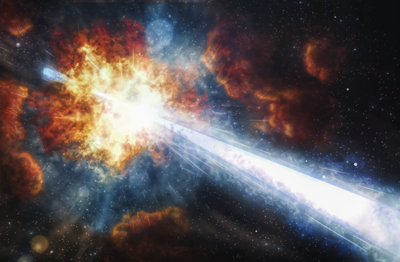Last October, astronomers witnessed the brightest gamma-ray burst ever seen by human instruments. A recent paper by Tanmoy Laskar et al ("The Radio to GeV Afterglow of GRB 221009A"), recently published in the Astrophysical Journal Letters as part of a special issue on this remarkable cosmic event, describes how the evolution of the fireball was tracked by an international group of astronomers and observatories, including the LT.
Gamma ray bursts (GRBs) are short intense bursts of gamma rays that appear to emanate from distant pointlike sources in the universe. They only last a few seconds to a few minutes, but are accompanied by longer afterglows in lower energy bands, from Xrays through UV and optical down to infrared, millimetre and radio waves.
Two types of GRBs are known, short and long, referring to the duration of the burst. Long GRBs, the subject of this paper, last up to a few minutes. It's thought that they happen when an accreting black hole or magnetar forms during a supernova. Matter is beamed at relativistic speeds out of the poles of the spinning black hole or magnetar, forming a jet that impacts the ambient gas that already existed outside of the star before it went supernova. The impact creates a "forward shock" in the gas that excites the electrons in the gas to extreme levels causing them to emit electromagnetic radiation, in a wide range of wavelengths, in a focused beam along the direction of travel of the jet.
This GRB was observed to explode on 9th October 2022 and was the brightest gamma-ray burst ever detected. Dr Dan Perley, one of the paper's authors, said the GRB was "quite possibly the brightest burst seen from Earth for the past 10,000 years". It's thought it was this bright because it was not only relatively close, but the jet axis, and so the beam of electromagnetic radiation, happened to be pointing almost right at Earth. The LT was one of the first optical telescopes to observe it from the ground, and was able to continue to follow it for more than a month as the radiation faded.
The paper describes in detail how the LT data was combined with data from other facilities (e.g. VLA, ALMA, Swift) to study the physics of the afterglow radiation.
Other GRB-related articles in the News Archive:
- LT catches its first Gamma Ray Burst
- Liverpool Telescope nails exploding star
- LT Unravels Mystery of Cosmic Blasts
- RINGO Wins Times Higher Education Supplement "Research Project of the Year" Award
- LT Detects 10% Optical Polarisation in Gamma-Ray Burst
- Liverpool Telescope Reveals Supernova Associated With New Type of Gamma-Ray Burst
- RINGO2 Used to Probe Early Evolution of Gamma Ray Bursts
- Rapid-response monitoring of a "nearby monster"
- A Milestone Gamma Ray Burst Study: GRB190114C



